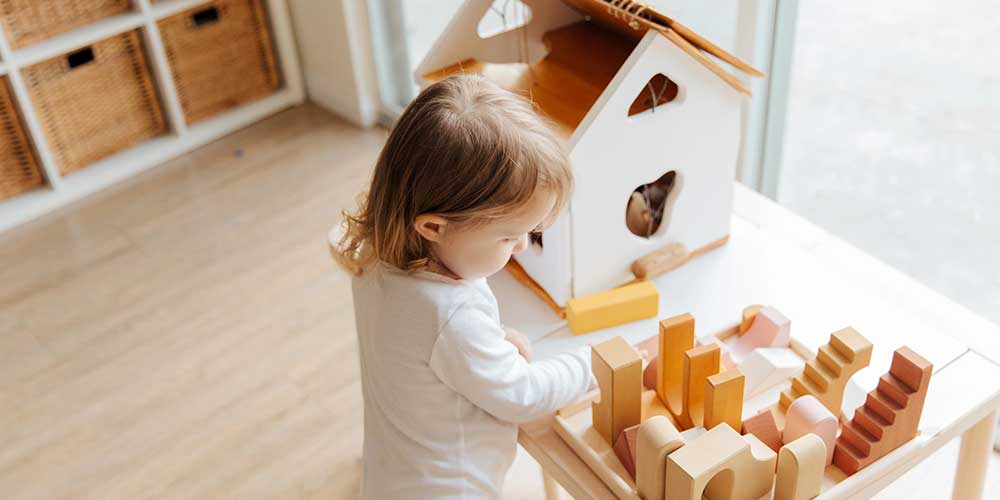Contents
- Montessori method
- What is a Montessori room?
- Montessori rooms for different ages
- Seven tips to make an amazing Montessori room
Would you be able to recognise a Montessori room if you saw one? What makes a Montessori room so special and how easy is it to set one up in your own home? Just follow our seven easy steps and your child will have a safe space for independent exploration, open-ended play and rest in no time. 🙌
The Montessori method
Maria Montessori (1870–1952) was an Italian physician and educator. Alongside an impressive and revered body of written works on scientific pedagogy, she developed a philosophy of education for young children – the Montessori method of teaching.
Through research, observation and practical application, Maria Montessori believed that giving children the freedom to make choices and in turn express their innate preferences within an environment prepared according to her model made for optimal educational and human development. 🧠
The Montessori approach differs from some conventional methods of teaching by placing less emphasis on measuring achievement through grading and testing, and more emphasis on setting up an intentional and supportive space. Within a Montessori environment, children – who are viewed as naturally eager for knowledge – can initiate their own learning. 💭
The general Montessori ethos goes beyond the classroom and has been widely adopted and integrated into daily and domestic life. Today, its influence can be seen and felt across the globe including Italy, the UK, Africa, India, Sweden, Latvia, the USA and many more. 🌍
If you’d like to support your child on their own learning journey, why not book a free trial lesson with one of our experienced GoStudent tutors today!
What is a Montessori room?
The Montessori approach is guided by a few key principles including respect for the child, sensitive periods – the notion that some periods are better for learning than others – and children’s innate capacity to lead their own education. The child’s mind is seen as highly absorbent making it all the more important to create carefully designed, safe and stimulating spaces, not just at school but at home too. 🏠
The main feature of a Montessori room is that everything is within the child’s reach, even from a very young age. By approaching the creation of your child’s bedroom from their perspective with a focus on stimulating all of the senses you will create a space that inspires confidence and exploration.
Benefits of a Montessori room
The Montessori approach is inherently child-centred and looks to encourage healthy child development without pressure or restrictions. Building a Montessori room for your child will help them to establish independence and autonomy, develop spatial awareness, understand physical boundaries, build self-discipline and foster healthy sleep patterns. 😴
Montessori rooms for different ages
Although the Montessori approach and general ethos can be applied to children’s development from early years right up until adolescence and beyond, naturally, the requirements of a child’s bedroom will change over time. Let’s take a look at some of the main features of a Montessori baby room and how it can be updated as your child grows up.
|
Baby 🍼 |
Toddler 👶 |
5+ 🧒 |
|
|
Floor bed |
Keep it very low, soft and simple. |
Add blankets and pillows now that it’s safe to do so. |
Add a night light next to the bed so they can read before sleep or if they awake early. |
|
Activities |
Place a soft rug in the room and keep a few eye-catching, sensory toys nearby. |
Add a low-lying shelf with room for toys and a basket of 4–6 books on rotation nearby. |
Add an easy plant to care for like a cactus, carnivorous plant or something that grows from seed. |
|
Furniture |
Make a baby-changing area and place a rattle, tactile toy or unbreakable mirror nearby. |
Install kid-friendly storage options like an IKEA kids shelf, low rail in the closet or wall hooks at your child’s eye level. |
Add a writing station or light table for independent reading, creativity and projects. |
|
Decoration |
Keep colours calm and neutral. Add family photos with recognisable faces to the wall. |
Add abstract, colourful shapes and animal images to wall displays at child height. |
Let them choose their own wall artwork by their favourite artists or posters from magazines. |
Seven tips to make an amazing Montessori room
When it comes to setting up a Montessori bedroom, you don’t need a qualification in interior design or even Montessori theory. Just remember that a Montessori room is designed to be a safe space for independent exploration, self-lead play and rest.
Switch up your perspective 👁️
The Montessori approach centres around the child’s point of view. It may seem a little odd but we suggest that you sit or lie on the floor and take a look around. Let this new vantage point influence how you decorate and organise the room.
Keep it simple 🙂
Montessori room decoration is clean and simple. Colours – typically neutral or muted – play a key role in promoting a sense of calm. They also allow vibrant objects like toys, photographs and artwork to draw attention instead.
Flexible lighting 💡
The bedroom needs to facilitate varied activities. Keeping lighting soft and warm with minimal glare creates a calm environment in the day while blackout blinds create a dark, cozy sleeping environment even when it’s light outside.
Toys 🧸
Keep a small, curated collection of toys available to your child at all times. Make sure they are accessible to your child so that they can entertain themselves freely by creating, storytelling and open-ended play.
The floor bed 🛏️
A floor bed is an integral part of the Montessori bedroom. They enable freedom of movement and decision-making as opposed to cribs, which can leave children dependent on parents to decide on their sleeping and waking patterns.
Accessible furniture 👍
Invest in child-scale furniture – like a small wardrobe, table and chairs – and hang hooks, displays and rails at their eye level. Build a self-care area with a mirror, hairbrush and tissues so your child can participate in caring for themselves.
Head to Ikea 🛍️
A Montessori room doesn’t need to break the bank. In fact, IKEA has a full range of affordable Montessori-friendly furniture including low shelves, step-stools, children’s armchairs, IKEA children’s bookcases, low beds, drawing easels and free-standing storage options like the classic KALLAX Shelf Unit – all perfect for Montessori-inspired living at home.










